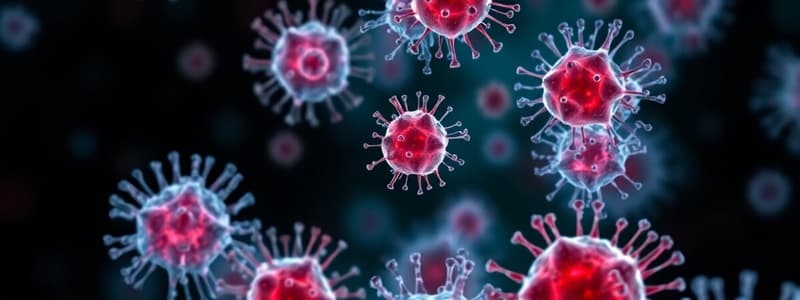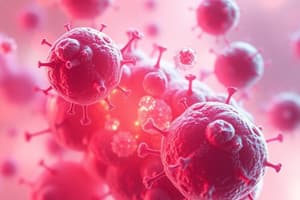Podcast
Questions and Answers
What factor primarily determines the differentiation direction of activated CD4+ T cells?
What factor primarily determines the differentiation direction of activated CD4+ T cells?
- Pathogen type (correct)
- Type of APC (correct)
- Activation of transcription factors (correct)
- Cytokines from effector cells
What type of T lymphocyte is primarily involved in the defense against intracellular pathogens?
What type of T lymphocyte is primarily involved in the defense against intracellular pathogens?
- Regulatory T cells
- CD8+ cytotoxic T cells
- CD4+ Th1 cells (correct)
- CD4+ Th2 cells
What role do Th2 cells play in defense against helminths?
What role do Th2 cells play in defense against helminths?
- Inhibit CD8+ T cell activation
- Stimulate eosinophil-mediated immunity (correct)
- Promote classical macrophage activation
- Activate phagocytes to kill microbes
Which cytokines are primarily secreted by CD4+ helper T cells to aid in immune responses?
Which cytokines are primarily secreted by CD4+ helper T cells to aid in immune responses?
What is the consequence of an imbalance between Th1 and Th2 cell activation?
What is the consequence of an imbalance between Th1 and Th2 cell activation?
What is the main function of CD8+ cytotoxic T lymphocytes?
What is the main function of CD8+ cytotoxic T lymphocytes?
Which activated CD4+ T cell type specifically activates phagocytes to kill ingested microbes?
Which activated CD4+ T cell type specifically activates phagocytes to kill ingested microbes?
How do CD8+ T cells induce cell death in infected cells?
How do CD8+ T cells induce cell death in infected cells?
Delayed hypersensitivity is classified as which type of immune response?
Delayed hypersensitivity is classified as which type of immune response?
What role do regulatory T lymphocytes play in the immune system?
What role do regulatory T lymphocytes play in the immune system?
What mechanism allows CD8+ effector T cells to ascertain the cells they are targeting?
What mechanism allows CD8+ effector T cells to ascertain the cells they are targeting?
Th1 CD4+ effector T lymphocytes contribute to cell-mediated immunity primarily by producing which of the following?
Th1 CD4+ effector T lymphocytes contribute to cell-mediated immunity primarily by producing which of the following?
What happens to a CD8+ T cell's target after granzyme B is delivered to its cytosol?
What happens to a CD8+ T cell's target after granzyme B is delivered to its cytosol?
Which of the following describes the role of Fas ligand in the action of CTLs?
Which of the following describes the role of Fas ligand in the action of CTLs?
What is a primary characteristic of CD4+ Th2 lymphocytes?
What is a primary characteristic of CD4+ Th2 lymphocytes?
Which of the following functions is associated with CD4+ helper T cells?
Which of the following functions is associated with CD4+ helper T cells?
Flashcards
Cell-mediated immunity (CMI)
Cell-mediated immunity (CMI)
A type of immune response that targets intracellular pathogens (e.g., viruses, bacteria within cells) and involves CD8+ cytotoxic T lymphocytes (CTLs) directly killing infected cells.
Th1 cell
Th1 cell
CD4+ helper T cells that produce cytokines (mainly IFN-γ) promoting phagocytosis and the activation of macrophages to destroy intracellular pathogens.
CD8+ T lymphocytes
CD8+ T lymphocytes
CD8+ cytotoxic T lymphocytes (CTLs) that kill infected cells by releasing cytotoxic substances like granzyme and perforin, leading to apoptosis.
Humoral immunity
Humoral immunity
Signup and view all the flashcards
Delayed hypersensitivity
Delayed hypersensitivity
Signup and view all the flashcards
Th2 response
Th2 response
Signup and view all the flashcards
Regulatory T cells (Tregs)
Regulatory T cells (Tregs)
Signup and view all the flashcards
Cytokines
Cytokines
Signup and view all the flashcards
What determines the differentiation of activated CD4+ T cells?
What determines the differentiation of activated CD4+ T cells?
Signup and view all the flashcards
What is the role of Th2 cells in fighting helminths?
What is the role of Th2 cells in fighting helminths?
Signup and view all the flashcards
Describe the difference between classical and alternative macrophage activation.
Describe the difference between classical and alternative macrophage activation.
Signup and view all the flashcards
How does the Th1/Th2 balance affect intracellular infections?
How does the Th1/Th2 balance affect intracellular infections?
Signup and view all the flashcards
How does the immune response to Mycobacterium leprae influence the severity of leprosy?
How does the immune response to Mycobacterium leprae influence the severity of leprosy?
Signup and view all the flashcards
How do CD8+ effector T cells kill infected cells via apoptosis?
How do CD8+ effector T cells kill infected cells via apoptosis?
Signup and view all the flashcards
Describe the cooperation between CD4+ and CD8+ T cells.
Describe the cooperation between CD4+ and CD8+ T cells.
Signup and view all the flashcards
What is the role of CD4+ T helper cells in the immune response?
What is the role of CD4+ T helper cells in the immune response?
Signup and view all the flashcards
Study Notes
Cellular Immune Response II
- Cellular immunity (CMI) defends against intracellular microbes
- T lymphocytes mediate CMI
- Some T lymphocytes activate phagocytes to destroy ingested microbes
- Other T lymphocytes kill infected host cells harboring microbes in the cytoplasm
Types of CMI Killing Microorganisms
- Involves CD4+ and CD8+ T lymphocytes
- These cells work together to eliminate different types of microbes
Types of CD4+ Helper T Cells
- Different types of CD4+ helper T cells exist (Th1, Th2, Th17, and others)
- Mechanisms determine their differentiation
- Certain cytokines drive the differentiation of T cells
- The types of cells promote different immune responses
Role of CD4+ Th1 Lymphocytes
- Th1 cells target intracellular pathogens
- They help macrophages fight off the intracellular microbes
Delayed Hypersensitivity
- A form of hypersensitivity, taking 24-72 hours to develop after exposure to an antigen.
- Delayed hypersensitivity is mediated by T cells, rather than antibodies
Role of CD4+ Th2 Lymphocytes
- These cells combat helminths (e.g., parasitic worms)
Ways CD8+ Effector T Lymphocytes Kill Infected Cells
- CD8+ cytotoxic T lymphocytes (CTLs) recognize infected cells carrying a specific intracellular microbe.
- CTLs then kill the infected cells
- CTLs use cytotoxic mechanisms, including releasing granzymes and perforin into the infected cell to induce apoptosis
Features of Regulatory T Lymphocytes
- Regulatory T lymphocytes (Tregs) suppress CMI
- They help maintain immune balance
Characteristics of Subsets of CD4 Helper T Cells
- Th1 cells release interferon-γ (IFN-γ) and target macrophages for intracellular pathogens, such as mycobacteria
- Th2 cells release cytokines like IL-4, IL-5, and IL-13 and combat parasites of helminths.
- Th17 cells combat extracellular pathogens, like bacteria and fungi
- Cytokines released from these cells trigger different inflammatory and immune response
General Properties of T Cell Cytokines
- T cell cytokines are transient responses to antigens.
- Cytokines usually act on the same cells that produce them or nearby.
- T cell cytokines have pleiotropic effects.
- T cell cytokines have redundancy.
Biological Actions of Selected T Cell Cytokines
- Different cytokines influence T cell proliferation, differentiation, and action.
- Some cytokines activate macrophages.
- Cytokines are necessary to activate other types of immune cells
Functions of Th1 CD4+ Effector T Lymphocyte
- Stimulate the production of antibodies to promote phagocytosis of microbes.
- Killing of microbes via the production of interferon (IFN) as a crucial component of cell-mediated immunity
Role of Th1 Cells in Defense Against Intracellular Pathogens
- Th1 cells activate macrophages in response to intracellular pathogens, resulting in bacterial killing
- These cells stimulate the production of several cytokines, including TNF and IFN
What is Delayed Hypersensitivity?
- An immune reaction taking 24-72 hours to develop after antigen exposure.
- It's mediated by T cells rather than antibodies
Mechanism Determining the Direction of Activated CD4+ T Cell Differentiation
- Pathogen type
- Cytokine from antigen presenting cells (APCs)
- Activation of transcription factors determines the direction of differentiation for T cells.
- Cytokine production from the effector cells
Role of Th2 Cells in Defense Against Helminths
- Th2 cells stimulate phagocytic cells like eosinophils, which fight against parasitic worms/helminths
- They also mediate antibody production (especially IgE) to combat helminthic infections
Classical & Alternative Macrophage Activation
- Macrophages play a crucial role in innate and adaptive immunity and can be activated in two ways:
- Classical activation (M1): activated by microbial products, resulting in inflammation.
- Alternative activation (M2): stimulated by cytokines that promote tissue healing, such as IL-4 or IL-13
Balance Between Th1 & Th2 Cell Activation
- The balance between Th1 and Th2 cell activation affects the outcome of intracellular infections.
- Th1 cells activate phagocytes to eliminate microbes, while Th2 cells inhibit classical macrophage activation.
Uncontrolled Mycobacterium Leprae
- Leads to lepromatous leprosy, characterized by uncontrolled bacterial growth.
How Can CD8+ Effector T Cells Kill Infected Cells?
- CD8+ T cells interact with infected cells
- These cells release granzymes and perforin to induce apoptosis
- This eliminates harmful reservoirs of infection
Cooperation Between CD4+ and CD8+ T Cells
- CD4+ T helper cells regulate and interact with CD8+ cytotoxic T Lymphocytes, assisting in the immune response towards infections.
- Cooperation between these cells efficiently eradicates infected cells.
What are Regulatory T Lymphocytes?
- Regulate T lymphocytes (Tregs) help to control and balance immune responses through their role in suppressing the immune system when necessary to maintain a healthy state.
- CTLA4 inhibits immune responses and shut down T cell responses
Studying That Suits You
Use AI to generate personalized quizzes and flashcards to suit your learning preferences.




